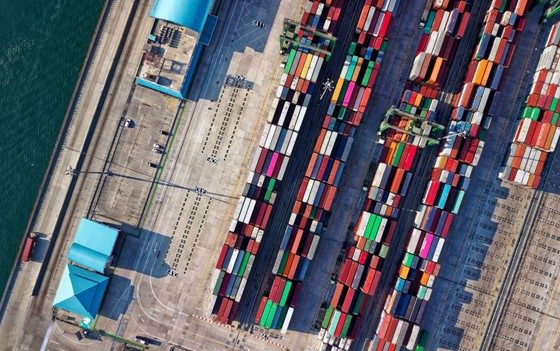6 Major Logistics Trends Shaping Logistics Management in 2022

The unwritten rule across any industry is that disruptive forces are constantly at play, reshaping the way organizations think about technology, conduct business, and look to the future. This is of course true for the logistics industry where market trends are impacting the sector to a great degree.
From new technologies to explore and take advantage of, to shifting regulations that require new strategies and tactics to ensure compliance, there is a lot to consider. Logistics companies must stay plugged into relevant and emerging trends to stay at the bleeding edge and remain competitive. Companies that succeed are the ones that accept the latest logistics industry trends and challenges and utilize technology in a way that enables them to capitalize. So how about you?
Going forward, how will the current emerging trends in logistics impact your business?
1) Supply Chain Agility
Business occurs faster than ever due to the constant rollout of technological advances. Companies and their supply chains must be nimble if they wish to remain or become competitive in today’s digital environment. To achieve supply chain agility, logistics companies can harness the power of self-managed onboarding, as well as change and exception management.
Self-managed services give direct, hands-on control to businesses, rather than relying on outside entities to complete tasks. For example, imagine your company wins a huge new client. If your business relies on managed services, your team will have to submit an onboarding ticket to the service provider. This ticket will end up in a queue behind all the requests that came before it from other companies. This means it could take days or weeks until the managed service provider onboards your new client, cutting into potential revenue and harming your new client relationship.
On the other hand, if your business is self-managing its integration solution, your team can immediately start the onboarding process. There is no backlog of requests that must be completed prior, so your business can start trading with your new client in as little as a few hours.
The same example applies to change and exception management. Data discrepancies, incorrectly coded order fields, and inaccurate inventory levels can be detrimental to a business. With self-service change and exception management, your company can address issues as soon as they occur, making the impact they have on your business minimal to none. Furthermore, any updates to your processes can be handled internally. Otherwise, your company would be at the mercy of the managed service provider to discover and fix any issues that occur in your system.
2) Embrace Complexity Through Automation
Automation is a key resource for modern businesses since it reduces costs and increases efficiencies, plus it frees your staff to do other, more productive activities. Logistics companies can harness the power of automation by implementing end-to-end integrations between backend WMS/ERP systems and the many eCommerce solutions that are growing in popularity.
As companies continue to implement more platforms and systems into their business processes, there is more data than ever to collect. Data is extremely useful when making business decisions. However, the increase in applications and /or platforms also means the data is spread across various locations. This requires users to hop between software solutions to find and compile data, which is a time-consuming and tedious process. Data collection is also error-prone since a human is manually sourcing it.
Integrating WMS/ERP and eCommerce can significantly streamline your business’ dataflows by automatically sourcing and compiling critical information from various locations. This information is then presented in one central location, reducing the length of time users waste hunting down pertinent data. The information presented is also up-to-date since it is collected in real-time. Additionally, data is presented in organized, visually appealing, and easy-to-understand formats.
With streamlined dataflows, your team can then optimize operational monitoring and management. By integrating your WMS/ERP and eCommerce, your team will have access to more complete data, along with greater insights into business processes. These insights will highlight areas of improvement. Your business can then analyze this data to optimize your processes. For example, the data can be used to optimize supply chain management, forecasting, quality control, and delivery management.
3) Customers Demand Data and Real-Time Visibility
Amazon has tremendously influenced consumer shopping behaviors and expectations. One impact of the so-called “Amazon effect” is that trading partners and consumers now expect constant updates on order location and delivery windows. This is largely due to Amazon’s notoriously fast delivery times (2-day and same-day shipping). So how can your business provide continuous updates to your clients throughout the shipping process?
To deliver real-time status updates to your clients, consider integrating your WMS/ERP with supply chain visibility platforms (such as project44 or FourKites). Integrating the platforms will enable your business to track and monitor order shipments, along with updating clients with real-time status updates. In return, your customers remain informed throughout the entire delivery process and can plan accordingly on their ends.
This works by having the supply chain visibility platforms monitor precise shipment locations. The shipment location data is then passed from the visibility platform to the WMS/ERP, which hosts all customer and order information. The WMS/ERP can then send automated delivery updates to customers. The visibility into shipment location and delivery times is highly valuable and beneficial to consumers, allowing them to better prepare and manage their business.
4) Supply Chain Transparency and Collaboration Mandate
Logistics companies experience countless moving parts daily. Real-time visibility into supply chains is essential for logistics companies to stay organized and manage their business. One way for them to achieve this is through integrating their EDI and APIs.
When integration is done right, EDI and APIs work together to provide better supply chain visibility and can even help with onboarding. API integration gives deeper insight into B2B integrations within your digital ecosystem, while EDI helps start and orchestrate business processes.
For example, EDI can be used to kick-start the ordering, shipping, and fulfillment processes. APIs on the other hand can be used for shipment tracking, status updates, and inventory management. When used in tandem, the two technologies complement each other by providing an all-encompassing view of a business’s supply chain and helping automate tasks. Automating tasks while increasing visibility helps companies to improve productivity, reduce errors, and grow revenue, all while having more control over their processes.
5) Less Than Truckload (LTL) Demand
With the rise in eCommerce popularity and the demand for faster shipping, logistics companies are being asked to make smaller shipments more frequently. This is because companies do not have time to wait until they have enough orders to fill up an entire carrier. One solution is LTL, also known as less than truckload. With this method, multiple smaller orders from various companies are placed on one carrier—creating a full load with numerous delivery stops. LTL has numerous benefits, including:
Cost
Customers are only charged for the portion of the carrier’s space that they use. Logistics companies can more completely fill their vehicles so they do not let valuable space go unused.
eCommerce
eCommerce moves fast. LTL is highly efficient, allowing customers to forgo the need to fill a complete carrier. Instead, customers can submit orders whenever they need. Logistics companies can satisfy customers’ demands by quickly delivering shipments without losing revenue due to unfilled space.
Small Business Friendly
Small businesses naturally experience lower sales than large corporations. Therefore, they likely do not have the demand to fill an entire carrier vehicle, nor the capital to pay for a half-filled load. LTL addresses this by letting small businesses only pay for the space they use. Logistics companies then receive more business since they can accept orders from small businesses.
Environmentally Conscious
LTL greatly reduces the environmental impact of shipping. This is because carriers are moving fuller loads, equating to less unused space in each shipment. Therefore, fewer carriers and trips are needed to deliver products, lowering emissions.
6) Digital Business Evolution
End-to-end automation and EDI modernization can greatly increase the productivity of event-based workflows. When events are mapped to an automated workflow, humans are removed from the equation. This means that there is no waiting for a human to complete a task before the next step in the process can occur. Rather, technology is utilized to quickly and accurately perform each step in the workflow.
For example, let’s say a retailer sends a logistics company an EDI 204 Motor Carrier Load Tender for an order of office supplies. The logistics company’s EDI software can nearly instantaneously respond to the 204 with an EDI 990 Response to a Load Tender—either accepting or declining the order. The two companies will use EDI technology to continue communicating until the event-based workflow is complete. Without end-to-end automation and EDI modernization, a human would have to manually complete each task which would require a lot more time.
As more businesses adopt and demand their trading partners to use EDI, logistics companies are finding it increasingly vital to implement an innovative and modern EDI system. Otherwise, they will risk losing out on business opportunities
Conclusion
Today’s logistics industry looks entirely different than it did 10 years ago. So, what will it look like in another 10 years? Here’s a look into the crystal ball.
Logistics industry trends, such as those outlined above, are going to continue to impact the industry well into the future. However, the success of trend-shaping nascent technologies requires that they are integrated with existing solutions and infrastructure.
Logistics operations must be capable of enabling processes like ingesting EDI load tenders, along with determining how future technology can be leveraged to increase margins. Businesses can then create a next-generation stack that leverages their previous technology investments while incubating big data, IoT, and omnichannel solutions, thus positioning them for the future.
Furthermore, the events of 2020, 2021, and 2022 have disrupted the entire supply chain including the logistics industry. The logistics landscape is riddled with uncertainty and disruption, but it is also ripe for digital transformation and new opportunities.
Companies that succeed in this environment and beyond will embrace a combination of the top logistics industry trends, becoming better equipped and resilient to supply chain shocks. As your company navigates through the remainder of 2022 and into 2023, consider how the current emerging trends in logistics may impact your business.
Source : cleo.com



